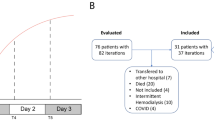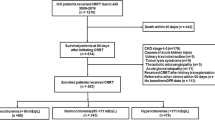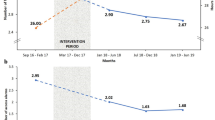Abstract
Measurement of renal function is important to optimize drug dosing in critically ill pediatric patients and to prevent dose-related toxicities caused by medications that are eliminated or metabolized by the kidney. In clinical practice, the 24-h creatinine clearance (CrCl) is used as a surrogate marker of renal function. However, a 24-h urine collection period delays the availability of the result and increases the potential for collection errors. This prospective, observational study was performed to determine whether a 12-h CrCl is comparable to the traditional 24-h CrCl and to assess whether CrCl could be reliably predicted by the Schwartz equation, which mathematically estimates a child's GFR. A 24-h urine sample was collected in two 12-h aliquots from 60 catheterized critically ill children (age 2 d to 18 y). CrCl and Schwartz glomerular filtration rate (GFR) estimates were determined for each 12- and 24-h period. Agreement between 12- and 24-h CrCl and between CrCl and Schwartz GFR estimates was assessed using intraclass correlation coefficients (ICCs). An ICC ≥0.8 was considered to indicate excellent agreement. The ICC between the first 12-h CrCl and 24-h CrCl was 0.9605. The ICC between the second 12-h CrCl and 24-h CrCl was 0.9602. The ICC between the 24-h CrCl and Schwartz GFR was only 0.7046. All comparisons of 12- and 24-h CrCl indicated excellent agreement. In summary, the Schwartz equation was not a reliable estimate of renal function in critically ill children, and a 12-h CrCl is just as accurate as the standard 24-h CrCl to assess renal function and guide drug dosing.
Similar content being viewed by others
Log in or create a free account to read this content
Gain free access to this article, as well as selected content from this journal and more on nature.com
or
Abbreviations
- CrCl:
-
creatinine clearance
- GFR:
-
glomerular filtration rate
- ICC:
-
intraclass correlation coefficient
- ICU:
-
intensive care unit
- SCr:
-
serum creatinine
References
Kwong MB, Tong TK, Mickell JJ, Chan JC 1985 Lack of evidence that formula-derived creatinine clearance approximates glomerular filtration rate in pediatric intensive care population. Clin Nephrol 24: 285–288
Wilson RF, Soullier G 1980 The validity of two-hour creatinine clearance studies in critically ill patients. Crit Care Med 8: 281–284
Hernandez de Acevedo L, Johnson CE 1982 Estimation of creatinine clearance in children: comparison of six methods. Clin Pharm 1: 158–161
Brochner-Mortensen J 1985 Current status on assessment and measurement of glomerular filtration rate. Clin Physiol 5: 1–17
Papp CM, Nahata MC 1995 Prospective evaluation of ten methods for estimating creatinine clearance in children with varying degrees of renal dysfunction. J Clin Pharm Ther 20: 67–73
Schwartz GJ, Brion LP, Spitzer A 1987 The use of plasma creatinine concentration for estimating glomerular filtration rate in infants, children, and adolescents. Pediatr Clin North Am 34: 571–590
Schwartz GJ, Haycock GB, Edelmann CM Jr, Spitzer A 1976 A simple estimate of glomerular filtration rate in children derived from body length and plasma creatinine. Pediatrics 58: 259–263
Robert S, Zarowitz BJ 1991 Is there a reliable index of glomerular filtration rate in critically ill patients?. DICP 25: 169–178
Cockcroft DW, Gault MH 1976 Prediction of creatinine clearance from serum creatinine. Nephron 16: 31–41
Ravel R 1995 Clinical Laboratory Medicine—Clinical Application of Laboratory Data, 6th Ed. Mosby-Year Book, Toronto, pp 166–177
Atiyeh BA, Dabbagh SS, Gruskin AB 1996 Evaluation of renal function during childhood. Pediatr Rev 17: 175–180
Kassirer JP 1971 Clinical evaluation of kidney function—glomerular function. N Engl J Med 285: 385–389
Hellerstein S, Alon U, Warady BA 1992 Creatinine for estimation of glomerular filtration rate. Pediatr Nephrol 6: 507–511
Springate JE, Christensen SL, Feld LG 1992 Serum creatinine level and renal function in children. Am J Dis Child 146: 1232–1235
Roy R, Griffiths K 2003 The 2003–2004 Formulary of Drugs—The Hospital for Sick Children, 22nd Ed. The Graphic Centre HSC, Toronto, pp 77
Donner A, Eliasziw M 1987 Sample size requirements for reliability studies. Stat Med 6: 441–448
Bland JM, Altman DG 1986 Statistical methods for assessing agreement between two methods of clinical measurement. Lancet 1: 307–310
Streiner DL, Norman GR 1995 Health Measurement Scales: A Practical Guide to Their Development and Use, 2nd Ed. Oxford University Press, New York, pp 104–127
Chatburn RL 1996 Evaluation of instrument error and method agreement. AANA J 64: 261–268
Bland JM, Altman DG 1990 A note on the use of the intraclass correlation coefficient in the evaluation of agreement between two methods of measurement. Comput Biol Med 20: 337–340
Muller R, Buttner P 1994 A critical discussion of intraclass correlation coefficients. Stat Med 13: 2465–2476
Portney LG, Watkins MP 2000 Foundation of Clinical Research: Applications of Practice, 2nd Ed. Appleton and Lange, Norwich, pp 557–586
Altman DG 1992 Practical Statistics for Medical Research. Chapman & Hall, New York, pp 403–409
Robert S, Zarowitz BJ, Peterson EL, Dumler F 1993 Predictability of creatinine clearance estimates in critically ill patients. Crit Care Med 21: 1487–1495
Martin C, Alaya M, Bras J, Saux P, Gouin F 1990 Assessment of creatinine clearance in intensive care patients. Crit Care Med 18: 1224–1226
Seikaly MG, Browne R, Bajaj G, Arant BS Jr 1996 Limitations to body length/serum creatinine ratio as an estimate of glomerular filtration in children. Pediatr Nephrol 10: 709–711
Fong J, Johnston S, Valentino T, Notterman D 1995 Length/serum creatinine ratio does not predict measured creatinine clearance in critically ill children. Clin Pharmacol Ther 58: 192–197
Richardson JA, Philbin PE 1971 The one-hour creatinine clearance rate in healthy men. JAMA 216: 987–990
Markantonis SL, Agathokleous-Kioupaki E 1998 Can two-, four- or eight-hour urine collections after voluntary voiding be used instead of twenty-four-hour collections for the estimation of creatinine clearance in healthy subjects?. Pharm World Sci 20: 258–263
Sladen RN, Endo E, Harrison T 1987 Two-hour versus 22-hour creatinine clearance in critically ill patients. Anesthesiology 67: 1013–1016
Baumann TJ, Staddon JE, Horst HM, Bivins BA 1987 Minimum urine collection periods for accurate determination of creatinine clearance in critically ill patients. Clin Pharm 6: 393–398
Herget-Rosenthal S, Kribben A, Pietruck F, Ross B, Philipp T 1999 Two by two hour creatinine clearance—repeatable and valid. Clin Nephrol 51: 348–354
Gambertoglio JG, Kearney BP 1999 Renal Disease. In: Anderson PO, Knoben JE, Troutman WG (eds) Handbook of Clinical Drug Data, 9th Ed. Appleton & Lange, Stamford, pp 912–935
Acknowledgements
We gratefully acknowledge the assistance and support of the nurses and physicians from the critical care unit. We also acknowledge both the Departments of Pharmacy and Critical Care Medicine at the Hospital for Sick Children for strong support and generous funding of this project.
Author information
Authors and Affiliations
Corresponding author
Additional information
Supported by the Department of Critical Care Medicine and the Pharmacy Department Research and Education Fund.
Abstract previously published in Can J Hosp Pharm 2003;56(suppl):S48.
Rights and permissions
About this article
Cite this article
Pong, S., Seto, W., Abdolell, M. et al. 12-Hour versus 24-Hour Creatinine Clearance in Critically Ill Pediatric Patients. Pediatr Res 58, 83–88 (2005). https://doi.org/10.1203/01.PDR.0000156225.93691.4F
Received:
Accepted:
Issue date:
DOI: https://doi.org/10.1203/01.PDR.0000156225.93691.4F
This article is cited by
-
Pharmacokinetics in Critically Ill Children with Acute Kidney Injury
Pediatric Drugs (2023)
-
DBnorm as an R package for the comparison and selection of appropriate statistical methods for batch effect correction in metabolomic studies
Scientific Reports (2021)
-
Augmented renal clearance in pediatric intensive care: are we undertreating our sickest patients?
Pediatric Nephrology (2020)
-
Augmented renal clearance in Japanese intensive care unit patients: a prospective study
Journal of Intensive Care (2016)



